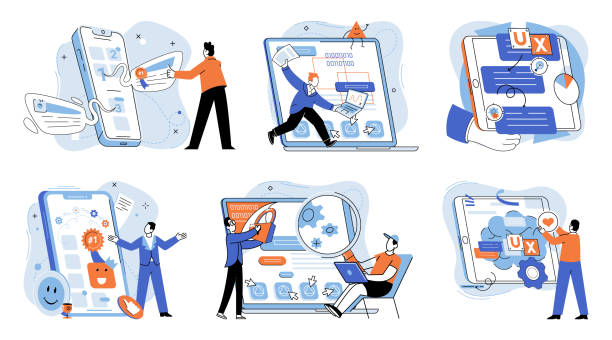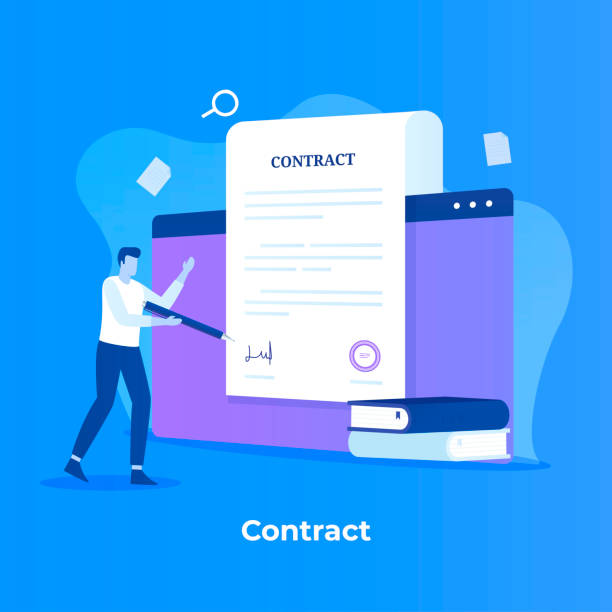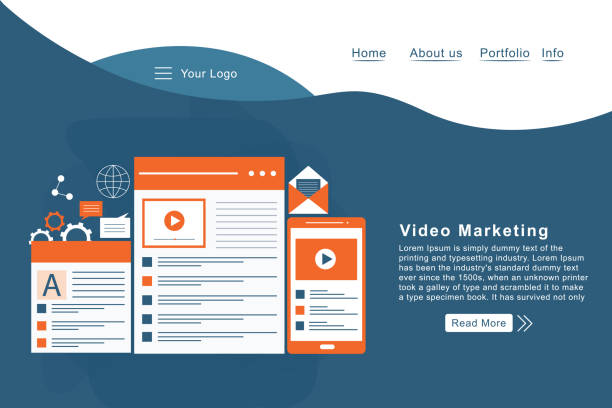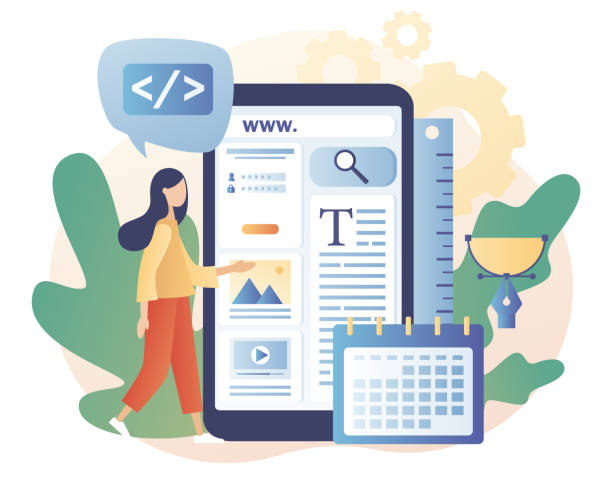Introduction to Responsive Web Design

In today’s world, where technology is advancing at an unprecedented pace, an online presence has become vital for every business and individual.
But merely having a website is no longer enough; its quality and performance have gained increasing importance.
#Responsive_Web_Design directly addresses this need.
This approach means creating websites that can automatically and intelligently adapt their layout and elements to the screen size of the user’s device (from mobile phones and tablets to laptops and large desktop monitors).
This concept is not merely a luxury feature but an undeniable necessity in the digital age.
When users visit your website with different devices, they expect a seamless and optimized experience, without needing to zoom or horizontal scroll.
Responsive web design ensures that your content is displayed correctly, buttons are clickable, and navigation is smooth.
This not only improves user experience but also plays a key role in search engine rankings.
This section is an explanation based on the basic principles and the ‘why’ of this technology’s importance, serving as a guide for a better understanding of its overall concept.
Simply put, by implementing responsive web design, you are essentially building a sustainable and user-friendly digital future.
Did you know a weak corporate website loses you many opportunities daily? Solve this problem forever with a professional corporate website design by Rasav!
✅ Create a powerful and reliable image for your brand
✅ Targeted attraction of new customers and increased sales
⚡ [Get Free Website Design Consultation]
Why is Responsive Web Design Essential?

Today, with the unprecedented increase in mobile device usage for internet access, having a website that only looks good on a desktop means losing a huge portion of your audience.
In fact, most internet users access the web from their smartphones or tablets.
Search engines like Google are also aware of this fact and prioritize responsive websites in their mobile search results.
This means that if your website is not responsive, it will likely rank lower in mobile searches, directly affecting your views and traffic.
Furthermore, a poor user experience can quickly drive users away from your website.
If a user has to constantly zoom or drag the page around to read content or click buttons, they will quickly become frustrated and leave the website.
Responsive web design solves this problem, providing a smooth and enjoyable experience for users on any device.
This approach also simplifies website optimization and maintenance, as there is only one single version of the website instead of multiple versions for different devices.
This section provides a comprehensive analysis of the main reasons for the necessity of responsive web design and is specialized content for a better understanding of today’s competitive web landscape.
Key Components of Responsive Design

Responsive web design is built upon three main pillars that, in cooperation, enable website adaptability.
The first pillar is “Fluid Grids”.
Instead of using fixed pixel units for element widths, relative units like percentages are used.
This means that the width of columns or content blocks is adjusted based on the total page width and changes proportionally with the screen size.
The second pillar is “Flexible Images”.
Images in responsive design must also have the ability to automatically resize.
This is typically done using CSS and setting properties like `max-width: 100%` to ensure images do not overflow their container and are scaled correctly.
For more advanced experiences, techniques like Conditional Loading of images or using the `picture` tag in HTML5 can be utilized.
The third pillar is “Media Queries” in CSS3.
This feature allows web designers to apply different CSS rules based on user device characteristics such as screen width, height, orientation (portrait or landscape), and even resolution.
Using media queries, layout, fonts, and other styles can be optimized for each screen size range.
This section specifically explains the technical components and serves as educational content for developers.
Next, we will compare fixed and responsive design in a table, clarifying the technical and practical details of each method.
| Feature | Fixed Design | Responsive Design |
|---|---|---|
| Element Sizing | Fixed pixels (e.g., 960px) | Relative units (percentage, em, rem, vw/vh) |
| Device Adaptability | No adaptation, requires horizontal scroll on mobile | Automatic and optimal adaptation to any screen size |
| Content Management | Requires separate versions or subdomains for mobile | Integrated, one codebase for all devices |
| Maintenance Cost | Higher (managing multiple versions) | Lower (one single version) |
| SEO Importance | Limitations for mobile SEO | Improved ranking in mobile searches |
| User Experience | Poor experience on different devices | Excellent and integrated user experience |
Benefits of Implementing Responsive Design

Implementing responsive web design brings countless benefits to website owners and users, going beyond mere aesthetics.
One of the most important advantages is improved user experience.
When your website automatically adapts to any device, users feel more comfortable and satisfied, which leads to increased engagement and reduced bounce rate.
The better the user experience, the higher the likelihood of users returning and converting into loyal customers.
Another advantage is improved website SEO.
Google and other search engines give special importance to responsive websites.
Responsive websites usually have only one URL per page, which makes it easier for Google to index pages and prevents duplicate content issues.
Additionally, better loading speed and a more desirable user experience on mobile devices are positive factors for ranking in search results.
Furthermore, responsive web design also helps save time and money.
Instead of developing and maintaining multiple separate versions of the website for different devices, only one codebase needs updating and management.
This significantly reduces initial development and long-term maintenance costs.
This section provides analytical content and guidance for understanding the various aspects of this approach’s benefits, offering a clear view of its usefulness.
These benefits are applicable not only to new websites but also to older websites looking for a revamp.
Are you tired of your company’s website not meeting your expectations? With Rasav, design a professional website that truly represents your business.
✅ Increase attraction of new customers and sales leads
✅ Enhance your brand’s credibility and trust with your audience
⚡ Get free website design consultation!
Common Challenges in Responsive Design

Despite its numerous advantages, implementing responsive web design is not without its challenges.
One of the main problems is content management for different screen sizes.
Sometimes, content that displays well on a desktop may appear too long or inappropriate on mobile.
This requires careful planning for how content is displayed and prioritized across different sizes.
Additionally, some graphical elements or animations may not work correctly on smaller devices or may slow down the site’s loading speed.
Another challenge is the discussion of “Performance”.
Although a responsive website should be lightweight and fast, if images are not optimized or there are many CSS and JavaScript files, it can lead to slow loading, especially on slower mobile networks.
Developers must consider image optimization, code compression, and the use of Lazy Loading techniques.
The complexity of development and testing is also a significant challenge.
Given the countless variety of devices and screen sizes, comprehensive website testing across all scenarios is difficult and time-consuming.
This requires the use of simulator tools and testing on real devices to ensure correct functionality and optimal user experience across all platforms.
This section contains specialized and thought-provoking content about the technical difficulties of responsive web design that developers should be aware of.
Finding a balance between aesthetics and performance in responsive web design is one of the main challenges.
Tools and Frameworks for Responsive Development

To facilitate the process of responsive web design, numerous tools and frameworks have been developed to help designers and developers build responsive websites with greater speed and efficiency.
One of the most popular and well-known frameworks is Bootstrap.
This framework provides a comprehensive set of CSS and JavaScript, including fluid grids, pre-built UI (User Interface) components, and responsive tools.
Using Bootstrap can significantly reduce development time.
Other frameworks like Tailwind CSS and Bulma also offer different approaches to responsive design.
Tailwind CSS is a utility-first framework that gives developers a very high level of control over styling, while Bulma is a lighter, modular framework that focuses on pure CSS.
In addition to frameworks, various tools exist for testing and debugging responsive design.
Browser developer tools (such as Chrome DevTools) provide the ability to simulate different devices and test media queries.
Online tools like Responsive Design Checker are also useful for previewing websites on different screen sizes.
These tools and frameworks offer practical and efficient guidance for anyone looking to work in responsive web design and are considered an important educational section.
Choosing the right tool depends on the project’s needs and the developer’s preferences.
The Role of User Experience in Responsive Design

User Experience (UX) plays a pivotal role in responsive web design.
A good responsive design is not just about correctly displaying the website across different sizes, but about providing the best possible experience for the user, regardless of the device they are using.
This includes aspects such as ease of navigation, high readability, easy access to key content, and optimal loading speed.
Mobile-First Design is one of the important approaches in this field, where design starts from the smallest screen and then expands towards larger devices.
This approach ensures that the most important elements and functionalities are optimized first for mobile users.
Focusing on simple and functional design across all devices is crucial.
This means that the design should avoid unnecessary complexities and ensure that all buttons and forms are large enough and clickable.
Also, the management of Whitespace and the visual hierarchy of content for each screen size must be carefully done so that the user can easily find the information they need.
A responsive website with poor UX can discourage users as much as a website that is not responsive at all.
This section is an analytical content and guide for a deeper understanding of the relationship between UX and responsive web design.
In the table below, we examine the key UX principles for a successful responsive design.
| UX Principle | Explanation in Responsive Design | Why it’s important? |
|---|---|---|
| Mobile-First | Start design and development from the smallest screen. | Ensures that the core user experience and content are optimized for the majority of mobile users. |
| Visual Hierarchy | Prioritizing and organizing content for readability at any size. | Users quickly find key information and confusion is avoided. |
| High Clickability (Tap Targets) | Buttons and links must be large enough. | Prevents touch errors and facilitates user interaction. |
| Loading Speed | Optimizing images and web codes for fast loading. | Reduces bounce rate, improves SEO, and increases user satisfaction. |
| Simple Navigation | Menus and navigation should be accessible and intuitive on any device. | Users can easily navigate the website and find desired content. |
| Optimized Forms | Input forms should be simple and comfortable for mobile typing. | Increases form completion rates and improves user experience. |
The Future of Web Design and Responsiveness

The future of responsive web design is inextricably linked to the evolution of technology and user expectations.
With the emergence of new devices such as smartwatches, flexible displays, and even virtual/augmented reality, the concept of responsiveness will go beyond mere screen sizes.
We are moving towards a “responsive experience,” where the website responds not only to size but also to the user’s context, including device type, connection speed, location, and even personal preferences.
One of the key trends in the future will be the increased importance of “performance” and “speed.”
Users expect websites to load instantly, and this becomes more challenging with increasing data and design complexities.
Advanced optimizations for images, fonts, and codes, as well as the use of techniques like Progressive Web Apps (PWAs) that offer an app-like experience in the browser, will gain increasing importance.
Artificial Intelligence (AI) and Machine Learning (ML) can also play a significant role in the future of responsive design, by providing tools that automatically optimize layouts or adjust content based on user behavior.
Responsive web design is no longer just an option; it has become the cornerstone of every successful web strategy.
This section is news content and thought-provoking content about future trends that offers a new perspective on this field.
Did you know a weak corporate website loses you many opportunities daily? Solve this problem forever with a professional corporate website design by Rasav!
✅ Create a powerful and reliable image for your brand
✅ Targeted attraction of new customers and increased sales
⚡ [Get Free Website Design Consultation]
SEO Optimization with Responsive Design

The connection between responsive web design and Search Engine Optimization (SEO) is very strong and vital.
Google has officially stated that responsive design is the preferred approach for mobile websites.
One of the main reasons for this is the concept of “Mobile-First Indexing”; meaning that Google primarily considers the mobile version of your website for ranking and indexing content.
If your website does not work well on mobile, it will have a direct negative impact on your search rankings.
Having a single URL for all devices (which is a key feature of responsive design) also significantly helps with SEO.
This prevents the creation of duplicate content and centralizes link equity to a single URL, thereby increasing your domain authority.
Also, the improved user experience that responsive design provides (such as high loading speed, easy navigation, and readable content) are all positive factors for Google’s ranking.
Google rewards websites that offer a better user experience.
Finally, reduced bounce rate and increased user time on the website, which are the results of a good responsive design, send positive signals to search engines.
This indicates that users find your content useful and relevant, which in turn can help increase your visibility and organic traffic.
This section provides specialized information and practical guidance on how responsive web design impacts SEO.
Practical Tips for a Successful Responsive Website Design

To ensure success in responsive web design, adhering to a few practical tips is essential.
First and foremost, always think with a “mobile-first” approach.
Designing for the smallest screen and then scaling up to larger screens ensures that the fundamental user experience is optimized for the majority of users.
This helps you focus on core content and essential functionalities.
Second, do not forget image optimization.
Large and unoptimized images can drastically reduce site loading speed.
Use appropriate image formats (e.g., WebP), compress images, and utilize the `srcset` attribute in HTML for providing images of different sizes based on the device.
This is a vital educational and explanatory section.
Third, testing on real devices is extremely important.
Browser simulators are useful, but nothing replaces testing on actual mobile phones and tablets.
This helps you discover touch, speed, and layout issues that might not be apparent in simulators.
Fourth, pay special attention to navigation design.
On small screens, extensive menus may need to be transformed into a hamburger button.
Ensure these collapsible menus are easily accessible and usable.
Fifth, use clean and optimized code.
The more organized and compressed your CSS and JavaScript codes are, the faster the site will load.
This section provides practical guidance and educational content that can help you effectively implement responsive web design.
Frequently Asked Questions
| Question | Answer |
|---|---|
| What is Responsive Web Design? | It is a method for designing and implementing websites that automatically adjusts the layout and content of the page to best display according to the screen size of the user’s device (desktop, tablet, mobile, etc.). |
| Why is responsive design important? | With the increasing use of various devices to access the web, a responsive site improves user experience, reduces bounce rate, strengthens site SEO, and simplifies site management and maintenance (instead of having separate versions for mobile and desktop). |
| How does responsive design work? | This type of design uses techniques such as flexible grids and layouts (Flexbox, CSS Grid), flexible images and media, and most importantly, CSS Media Queries to change page styles and layouts based on screen characteristics (width, height, resolution, etc.). |
| What are the main tools for implementing responsive design? | The main tools include HTML5 (for content structure), CSS3 (especially Media Queries, Flexbox, Grid for responsive styling and layout), and sometimes JavaScript for more complex interactions. |
| What are the main benefits of using responsive design? | The main benefits include increased user accessibility (covering a wide range of devices), improved user experience, enhanced site ranking in search engines (especially Google), reduced development and maintenance costs, and increased visitor-to-customer conversion rates. |
And other advertising services from RasaWeb Advertising Agency:
Smart Sales Automation: Designed for businesses seeking to increase sales through intelligent data analysis.
Smart SEO: An innovative service for increasing online growth through optimizing key pages.
Smart UI/UX: An effective tool for digital branding by optimizing key pages.
Smart SEO: A fast and efficient solution for online growth focusing on using real data.
Smart SEO: Designed for businesses seeking to increase click-through rates through attractive user interface design.
And over hundreds of other services in internet advertising, advertising consultation, and organizational solutions.
Internet Advertising | Advertising Strategy | Advertorials
Transform your business in the online world with Rasav Afarin Digital Marketing Agency; from fast website design to comprehensive SEO strategies.
📍 Tehran, Mirdamad Street, next to Bank Markazi, Kazeroun Jonoubi Alley, Ramin Alley, No. 6
Resources
The Importance of Responsive Web Design in the Digital Future
The Digital Future with a Responsive Design Approach
Comprehensive Guide to Responsive Web Design
Benefits of Responsive Website Design for Businesses



